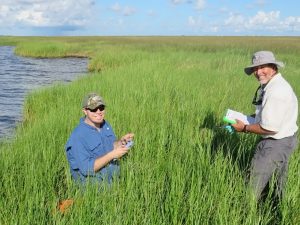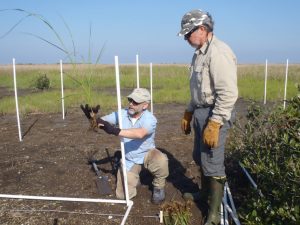Study Uses Fiddler Crabs and Periwinkle Snails to Monitor Long-Term Marsh Health after Oil Spill
– DECEMBER 12, 2017
Researchers in Florida and Louisiana extended a Natural Resource Damage Assessment (NRDA) of fiddler crabs and periwinkle snails after the Deepwater Horizon incident to assess marsh recovery from oiling. The team found that fiddler crabs, the more mobile of the two species, had mostly recovered by 30 months in terms of size, density, and species composition. The density of periwinkle snails recovered within 60 months at moderately oiled sites where Spartina alterniflora aboveground biomass was highest. However, their mean shell length, which seemed to be recovering by 48 months in moderately and heavily oiled sites, declined after that. The authors concluded that full recovery of heavily oiled marsh sites, similar to the periwinkle snails experience, will take longer than 66 months. The researchers published their findings in PeerJ: Shoreline oiling effects and recovery of salt marsh macroinvertebrates from the Deepwater Horizon Oil Spill.
Much of the marsh habitat within Louisiana’s Barataria Bay consists of marsh islands, whose edges were oiled after the spill. Fiddler crabs and periwinkle snails live in these areas and release eggs into the surrounding waters. The larvae return to the marsh edges to continue their development. This study continued a 24-month NRDA monitoring of these species because, as author Donald Deis explained, “The least mobile species are the ones that truly indicate the health of the environment.”
The team collected macroinvertebrates, surface soils, and plant biomass from November 2012 to October 2015 at sites with no, moderate, and heavy oiling. Using two methods of Analysis of Covariance, the team analyzed the sizes and densities of both species relative to the degree of oiling and time.
Fiddler crab recovery at moderately and heavily oiled sites as compared to the reference sites included the return of Uca longisignalis dominance, density, and size. Periwinkle density and Spartina alterniflora stem density were higher at moderately oiled sites than reference or heavily oiled sites, suggesting that the snail’s growth and survival were positively correlated with the availability of this marsh grass. Declines in periwinkle snail shell length, as indicated by reduced relative abundance of larger adult snails, could be due to decreased survival, slowed growth rates, or young adults leaving the oiled area.
“Our team has continued to follow the recovery of the system,” said Deis. “The periwinkle is dependent on S. alterniflora, a foundational species in these marshes, for much of its life cycle. The marshes in Louisiana are a significant fish and fisheries habitat and are eroding at a rapid rate. Our study helps to show the importance of recovery to the marsh ecosystem as a habitat for fish and fisheries and to prevent erosion.”
Data are publicly available through the Gulf of Mexico Research Initiative Information & Data Cooperative (GRIIDC) at doi:10.7266/N7FF3Q9S.
The study’s authors are Donald R. Deis, John W. Fleeger, Stefan M. Bourgoin, Irving A. Mendelssohn, Qianxin Lin, and Aixin Hou.
The authors published a related study that looks at meiofauna recovery six years after the oil spill: Recovery of saltmarsh meiofauna six years after the Deepwater Horizon oil spill.
************
This research was made possible in part by a grant from the Gulf of Mexico Research Initiative (GoMRI) to the Coastal Waters Consortium II (CWC II).
The Gulf of Mexico Research Initiative (GoMRI) is a 10-year independent research program established to study the effect, and the potential associated impact, of hydrocarbon releases on the environment and public health, as well as to develop improved spill mitigation, oil detection, characterization and remediation technologies. An independent and academic 20-member Research Board makes the funding and research direction decisions to ensure the intellectual quality, effectiveness and academic independence of the GoMRI research. All research data, findings and publications will be made publicly available. The program was established through a $500 million financial commitment from BP. For more information, visit https://gulfresearchinitiative.org/.
© Copyright 2010-2017 Gulf of Mexico Research Initiative (GoMRI) – All Rights Reserved. Redistribution is encouraged with acknowledgement to the Gulf of Mexico Research Initiative (GoMRI). Please credit images and/or videos as done in each article. Questions? Contact web-content editor Nilde “Maggie” Dannreuther, Northern Gulf Institute, Mississippi State University (maggied@ngi.msstate.edu).







